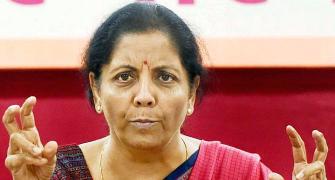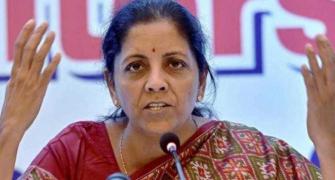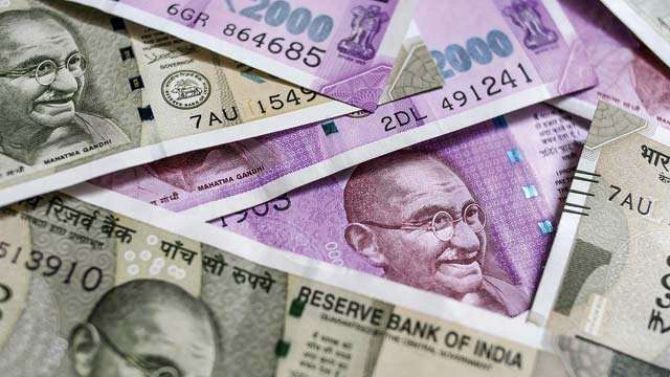Budget-makers in North Block are looking to maintain this fiscal status quo, in spite of tax revenues nowhere close to where the government wants and in spite of possible higher expenditure commitments.
Illustration: Uttam Ghosh/Rediff.com

When Finance Minister Nirmala Sitharaman presents her first Union Budget in the Lok Sabha on July 5, she is highly likely to forecast a fiscal deficit target for 2019-20 (FY20) at 3.4 per cent of gross domestic product (GDP), retaining the figure of the FY20 interim Budget presented on February 1.
Budget-makers in North Block are looking to maintain this fiscal status quo, in spite of tax revenues nowhere close to where the government wants and in spite of possible higher expenditure commitments.
The reasons are, first, that while the finance ministry officials know of the challenges they face in order to achieve an increasingly steep target of 3.4 per cent, they are also aware of the impending recommendations of the Fifteenth Finance Commission which will lay down the devolution of the taxable pool between the Centre and the states.
“The headline fiscal deficit budgeted estimates for FY20 will be largely unchanged from the interim Budget,” said a senior government official.
“The Centre will wait for the Finance Commission report, and how much it will extract from the Centre’s resources, before taking a call on any fiscal expansion in the 2020-21 (FY21) Budget, if necessary,” the person said.
The second reason why there may not be any deviation from the target set in the interim Budget is Prime Minister (PM) Narendra Modi himself.
“The PM has been very particular about maintaining fiscal discipline. Till the year goods and services tax (GST) was implemented, there wasn’t any slippage.
"He feels strongly about the Centre’s credibility being tied to its ability to meet budgeted targets,” said a second official, adding: “The fiscal deficit target is now more a political decision than an economic one.”
In Modi’s first term, the then finance minister Arun Jaitley inherited a fiscal deficit target of 4.1 per cent of GDP from the Manmohan Singh government in 2014-15.
It ended the first term with a deficit of 3.4 per cent of GDP in 2018-19 (FY19), which was, nevertheless, the second consecutive year that the Modi administration missed its fiscal deficit target.
A number of officials told Business Standard that the political and bureaucratic establishment is aware of the growth slowdown which will impact tax revenues in FY20.
Figures given in the interim Budget showed that corporate tax collections would be higher by 15 per cent in FY20 over actual collections in FY19 and that personal income-tax collections would increase by an even greater proportion - by 34 per cent.
The Central Board of Direct Taxes has asked for a reduction of the target as growth is wavering.
GST collection, closely related to the health of the economy, is projected to increase by 31 per cent in the interim Budget for FY20 over actual collections in FY19.
While it is not yet clear if the Budget-makers will accede to the Board’s request to reduce the direct tax target, the overall total revenue target, which includes tax revenue, non-tax revenue, and non-debt capital receipts, will certainly not be reduced.
For this, the Centre is counting on some sort of a windfall from the Reserve Bank of India after the awaited recommendations of the Bimal Jalan panel and anticipating that the disinvestment target of Rs 90,000 crore could be exceeded, officials say.
As far as expenditure is concerned, the Centre has already expanded the PM-Kisan scheme to all landed farmers, leading to an additional outlay of roughly Rs 12,000 crore.
Pension schemes for farmers and traders have also been launched.
Additionally, officials expect some more of the Bharatiya Janata Party’s manifesto promises to be reflected in the Budget.
“Overall, the total size of the Budget could increase slightly.
"However, the aim will be to find money for the new schemes and announcements by making adjustments within the top line by diverting sums from other spending commitments,” said the first official.
Multiple officials conceded two things which don’t bode well for the quality of the fiscal deficit.
Firstly, that pending fertiliser and fuel subsidy numbers could be rolled over even further and that the finance ministry’s reliance on off-Budget financing will continue.
Even to meet the 2018-19 fiscal deficit target of 3.4 per cent, the government had leaned on state-owned organisations such as the Food Corporation of India, the Housing and Urban Development Corporation, the National Housing Bank, the National Bank for Agriculture and Rural Development, and the Rural Electrification Corporation for off-Budget borrowings to meet its expenditure on account of food subsidies, affordable housing schemes, irrigation, rural housing, and rural electrification.
Moreover, the amount of such off-Budget borrowing was as huge as Rs 1.32 trillion.
“These factors are a concern. Again, pending subsidies and reducing off-Budget borrowing is something the Centre will deal with more aggressively from the FY21 Budget onwards, after the Finance Commission report,” said a third official.
Another built-in assumption is that, with nine months left, the government will have some savings on welfare and infrastructure schemes.
“This Budget will be an incremental one. You could see savings on flagship schemes and infrastructure projects, which won’t be completed on time to release the allocated funds.
"Remember thats the government saved a healthy amount on PM-Kisan in FY19,” the person said.
Sitharaman and her team have begun Budget preparations in earnest, with the finance ministry under ‘quarantine’ from June 10 onwards.
Over the coming weeks, she will meet industry bodies and other stakeholders.
“The full Budget is different this year in that the interim Budget is already ready, with the numbers tied down.
"There will be some minor changes and the speech will be different from February but, in essence, it is the same Budget, with identical forecasts,” an official said.









